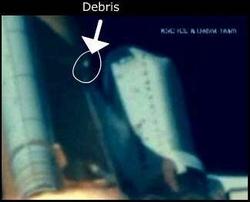Gehman: "We've Decided That These Things Are Equal"
 NASA Administrator Sean
O'Keefe was expecting a stinging report from the board
investigating the shuttle Columbia's demise. Friday, he got some of
what he'd been expecting. The chairman of the Columbia Accident
Investigation Board, in his final formal briefing, was quoted in
the "Washington Post" as saying, in deciding which factor
contributed more to the latest shuttle disaster -- the impact of
foam or errors in NASA's decision-making -- board members chose not
to decide.
NASA Administrator Sean
O'Keefe was expecting a stinging report from the board
investigating the shuttle Columbia's demise. Friday, he got some of
what he'd been expecting. The chairman of the Columbia Accident
Investigation Board, in his final formal briefing, was quoted in
the "Washington Post" as saying, in deciding which factor
contributed more to the latest shuttle disaster -- the impact of
foam or errors in NASA's decision-making -- board members chose not
to decide.
"We've now decided that these things are equal," he said.
That statement from Adm. Harold Gehman (USN,
ret.) could mean huge changes ahead for the space agency in the way
it handles manned flight. His statement came less than a week after
Monday's test of fuel tank insulating foam against the reinforced
carbon carbon wing of the shuttle.
Blasting the chunk of foam debris at the wing element at more
than 500 mph, engineers at the Southwest Research Institute in San
Antonio (TX) ripped a 16- to 17-inch hole in the wing panel. It
also broke an adjoining T-seal and caused a spider's web of cracks
to form in the rest of the RCC panel.
The Acorn From Which A Tree Grew
Gehman said, even though they didn't have the data to
back up the claim, NASA engineers refuted the possibility that the
foam strike on Columbia's left wing, shortly after its January 16th
launch, could have damaged the spacecraft to the extent that it
disintegrated upon re-entry on February 1st. The foam that peeled
away from the shuttle's external fuel tank and smacked the left
wing was almost twice as big as the next similar foam chunk.
 That assumption, said
Gehman, led to a series of bad decisions and errors in judgment
that included NASA's refusal to heed requests from engineers for
spy satellite photos of the left wing. Based on Monday's test in
San Antonio, several board members said the damage might well have
been spotted by photo reconnaissance while the space plane was
still safely in orbit.
That assumption, said
Gehman, led to a series of bad decisions and errors in judgment
that included NASA's refusal to heed requests from engineers for
spy satellite photos of the left wing. Based on Monday's test in
San Antonio, several board members said the damage might well have
been spotted by photo reconnaissance while the space plane was
still safely in orbit.
Even as Columbia was still circling the planet, NASA managers
sent an e-mail to the seven doomed crew members, telling them the
foam strike was "not even worth mentioning."
Gehman told reporters Friday, "It tells me how widespread and
deeply ingrained this sense was that foam can't hurt an orbiter.
The fact that this piece of foam . . . is much, much larger than
NASA's previous experience is, of course, important, because it
gets into the question of why didn't that alarm the engineers in
the program? That's kind of basic to our investigation."
NASA Will Probably Have Someone Looking Over Its Shoulder
Gehman said the board has no doubt that NASA
can address the mechanical issues raised by the death of Columbia
and its crew. But in an indication of things to come for the space
agency, he indicated the CAIB will likely recommend an independent
commission be created to monitor the changes board members think
NASA has to make in order to better ensure astronauts' safety.
NASA, it would seem, needs a babysitter.
What's Next?
The board has delayed until August the release of its final
report. That document will be included in Congressional hearings on
the shuttle disaster scheduled to begin after lawmakers return from
their summer recess. The "Post" reports witness lists in the Senate
and the House will almost undoubtedly contain the names of present
and former NASA officials who were called before the CAIB to
testify in secret.
 Aero-News: Quote of the Day (11.26.25)
Aero-News: Quote of the Day (11.26.25) ANN's Daily Aero-Term (11.26.25): Takeoff Hold Lights (THL)
ANN's Daily Aero-Term (11.26.25): Takeoff Hold Lights (THL) ANN's Daily Aero-Linx (11.26.25)
ANN's Daily Aero-Linx (11.26.25) Airborne Affordable Flyers 11.20.25: Sonex $$$, SnF 26 MOSAIC DAY, P. Ponk STCs
Airborne Affordable Flyers 11.20.25: Sonex $$$, SnF 26 MOSAIC DAY, P. Ponk STCs ANN's Daily Aero-Linx (11.27.25)
ANN's Daily Aero-Linx (11.27.25)




